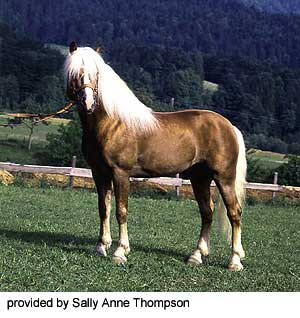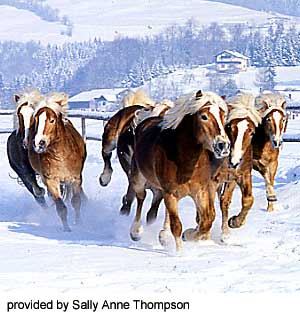

Haflinger


Introduction: If you have any comments or suggestions, please click here.
Names: Haflinger, Haflinger Pony.
Origin: Comes
from the Tyrol Mountains, Austria. Breeding area and studs--Alpine
districts, South Tyrol, Meran, Bozen Becken. Central Stud: Santa
Maria. Tyrol, Vorarlberg, Bavaria; Stud: Landshut. Schevaiganger
district; Stud: Uebersee.
A breed of small but sturdily built horses from the Austrian
Tyrol, the Haflinger is used as an all-purpose pony in rugged, mountain country.
In the 1930s, Arab blood was introduced into the original Haflinger, and since
then a new type of the breed, "less peasant and more aristocrat," has been
developed. The color is no longer dark bay or black, but more of a
palomino--a "golden roan," as one observer put it. The long, flowing mane
and tail are of the color of "bleached straw." The high intelligence of
the Haflinger, along with its unchanged placid disposition, makes it an ideal
circus horse. The breed is popular in Holland, and has more recently been
introduced into England and other countries. It is there used both as a
draft animal and a riding pony.
Breeding: Has some Arab blood. The Haflinger is a fairly old breed. After the Napoleonic wars an Austrian Commission brought from Arabia, El Bedair, who mated with the Arab mare Koheil and produced El Bedair II. In 1868 El Bedair XXII was crossed with a Tiroler Hafling mare belonging to a farmer called Folie; this mare produced the chestnut stallion Folie in 1874. All Haflinger ponies trace their pedigrees back to this stallion.
Description: Resembles a medieval knight's miniature charger! The whole horse is virtually packed with muscle; stocky, well-built.
Action: Not very fast, but nevertheless extremely surefooted. Very industrious in all three gaits but does not cover much ground. Climbs and jumps like a mountain goat.
Body: Powerful, well-placed neck. Rather steep shoulders. Broad back and loins. Quarters often oblique.
Color: Chestnut with flaxen mane and tail. Commonest colour is more or less dark chestnut with light mane and tail.
Head: Heavy. Small, rather refined, reflecting the Arab influence.
Hooves: Short, hard, and exceptionally sound.
Legs: Strong, healthy, and hard with clearly defined joints and tendons. Sometimes slightly bow-legged; short pasterns.
Size: About 14 hands.13.2 to 14.2 hands.
Temperament: Good-natured and willing. Lively.
Features: Very strong and surefooted. Hardy. Excellent, not too small all-round pony. Extraordinarily powerful, hard, economical, surefooted, mountain pony of robust constitution.
Uses: Ideal for forestry work, pulling and carrying loads on steep hillsides. Also ridden, and driven in harness. Pairs are used to pull sleighs up the snowy slopes at St. Moritz, with red harness and silver bells setting off their chestnut coats and flaxen manes and tails. Ideal pack animal for mountain troops.
Accomplishments:
Curiosities:
Profiles:
Conclusion: